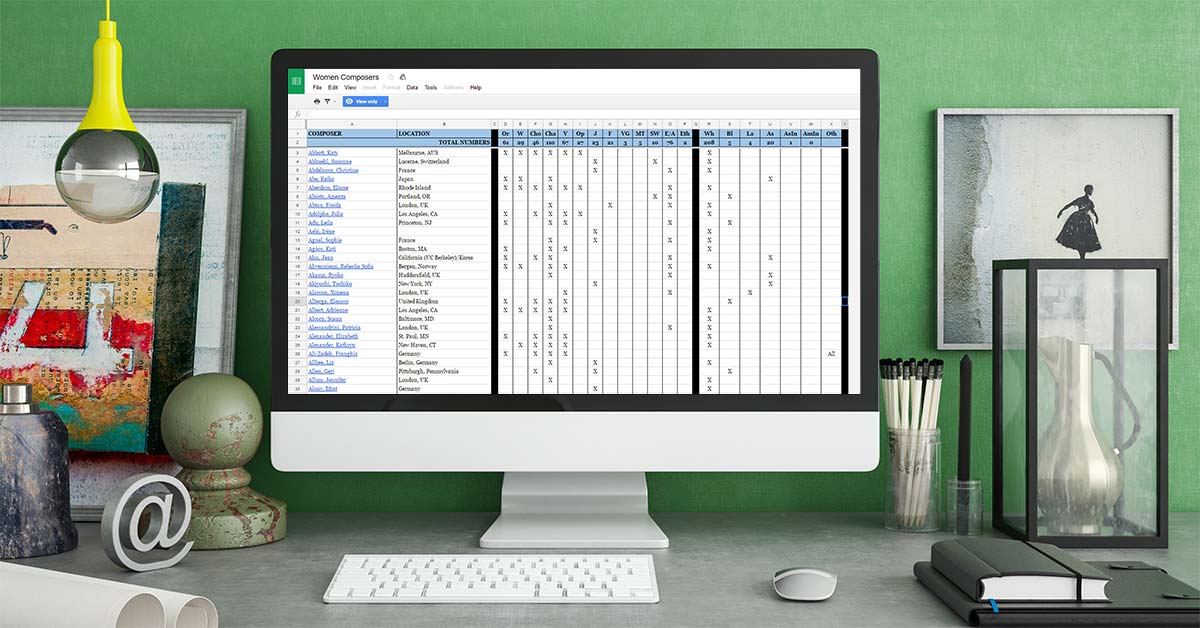The Institute For Composer Diversity (ICD), which evolved from the Women Composers Database project, released their initial 2019-2020 season report. The report tracks the overall number and percentage of masterworks series works from women composers and composers of color.
The online report provides concise datasets that illustrate each orchestra’s percentage and number of works in total season along with their League of American Orchestras group number.

Since we’re neck-deep in 2019-2020 season announcements, you can expect the report to be updated as new information is released. In addition to the rankings, lists, and scorecard ICD makes the raw data available via Google sheets.
ICD has grown considerably over the last year and the latest incarnation moves the group into the realm of a genuine influencer.
Their About page provides a concise breakdown of the organization’s mission and vision along with a description of how they operate within the School of Music at the State University of New York at Fredonia. The only thing missing is an overview of their history.
I reached out to ICD’s Head of Engagement and Marketing, Jamie Leigh Sampson, to see what’s in store as more info rolls in for the 2019-2020 season.
“We plan to evaluate approximately 150 orchestras in total, then provide concrete steps and resources for musicians, audiences, and administrators to encourage more diverse representation in their seasons,” said Sampson. “Orchestras are only a portion of the programming equation, but our hope is that by providing transparency and specific goals we will achieve greater balance and inclusion throughout the concert music world.”
An Entry Point Into Deeper Analysis
The current reports do a fabulous job at providing a top-level overview of programming data. It’s very similar to the nature of the annual orchestra compensation reports here at Adaptistration in that they serve as the starting point for quantifying a broader understanding and inspiring deeper analysis.
Like all good data reports, ICD’s 2019-2020 report engenders several intriguing questions.
For example, are orchestras with higher percentage of women and composers of color distributing those works across all masterworks concerts or lumping them together in something like showcase events.
After all, how many orchestras have you come across that program works from African American composers during Black History Month but nowhere else in their season.
While it’s great to see orchestras increase the diversity of their programming, it will be helpful to know if those efforts are genuine or more of an attempt to check-off grant requirements or serve as meat for the PR grinder.
Granted, I’m the first to admit I look at the field through jade colored glasses, but it is precisely this level of analysis that helps identify orchestras that take the time to approach diversity with genuine sincerity.
According to ICD Director, Rob Deemer, the organization is moving toward a point where they can provide that much depth in their datasets.
Having said that, there’s still a good bit more to discern from the data than the overall numbers and percentages. I asked Deemer about any intriguing analysis nuggets he’s uncovered.
“It seems that there’s a ceiling of three to eight diverse composers per season, irrespective of how many works are in the season,” said Deemer. “My guess is that there’s a perception issue here—folks see a handful of composers who aren’t white men in a program and think that’s enough. Our site’s “scorecard” lists orchestras that programmed three or more of at least one composer. If every orchestra we’ve looked at limited the number of works by a single composer to two, there would be over 200 slots amongst 35 orchestras that would have opened. Finally, just as there’s an increase in the number of Beethoven’s works because of his 250th birthday, it will be interesting to see if the women composer numbers stay high after next year’s centenary of the women’s right to vote.”
Deemer also confirmed the organization plans to roll out additional spreadsheets of data for previous seasons. This could happen as soon as March 2019 and once available, will be a treasure trove of open source programming data.
Moving forward, you need to bookmark the ICD website. There’s a wealth of resource content alongside the databases and research material.
Lastly, if your orchestra isn’t already on their 2019-2020 list, be sure to reach out via the contact form at the bottom of the current season’s report.


